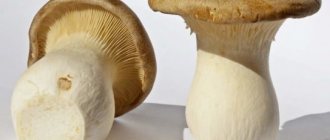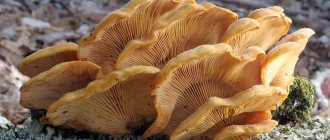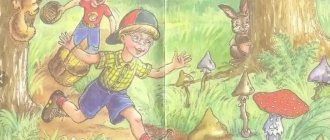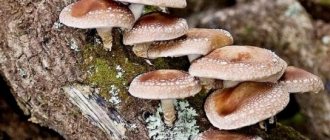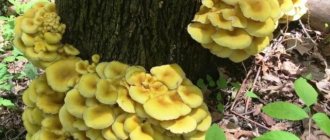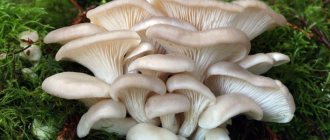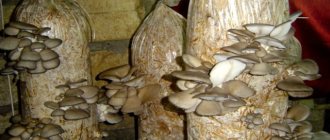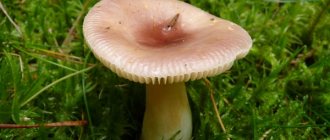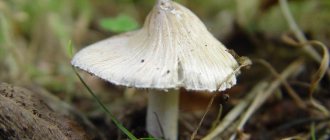Short description
| Type of mushrooms: | Edible |
| Other names (synonyms): | Oyster mushroom whitish, spring oyster mushroom, beech oyster mushroom. |
| Latin name: | Pleurotus pulmonarius |
| Family: | Pleurotaceae |
| Distinctive feature: | Oyster mushroom is a fairly common species and is an edible mushroom. |
| Beginning of the season: | May |
| End of season: | October |
| Leg height (cm): | 1-4 cm |
| Cap width (cm): | 3-10 cm |
| Smell: | nice |
| Taste: | mushroom |
| Tasting score: | [kkstarratings] Have you tried this mushroom? Then rate it! |
| Hat: | ear-shaped, lobed or irregularly shaped, slightly concave, prostrate or convex, with a smooth or wavy sharp edge, sometimes slightly tucked, smooth or sparsely scaly, often with radial hygrophanic zones, white, cream, grayish, ocher, or café-au-lait. |
| Leg: | short or absent, lateral or eccentric, cylindrical, solid, white, pubescent at the base |
| Hymenophore (bottom of cap): | the plates are sparse, thick, descending along the stalk, white in color. |
| Disputes: | ellipsoidal, sometimes slightly almond-shaped, 7.5 – 12 × 3 – 4.5 µm. |
| Pulp: | gray-white color. |
| Natural environment and mycorrhiza: | groups on dead wood at different stages of decomposition, mainly on deciduous trees, less often on conifers (spruce, fir). |
| False doubles: | similar to Pleurotus ostreatus but with some notable differences. The caps of the pulmonary tree are much paler and smaller than those of the osteopathic tree, and larger stalks develop. Pleurotus pulm also prefers warmer weather than ostreatus and appears in late summer. |
| Growing: | cultivated on an industrial scale. |
| Use: | edible when young. |
| Medicinal properties: | – |
| Spreading: | everywhere |
Oyster mushroom is light in color and prefers to grow on dying trees. It is often found in large quantities. Oyster mushroom is one of the most commonly found mushrooms and a favorite of mushroom pickers.
Oyster mushroom (Pleurotus pulmonarius) – Mushrooms of Siberia
Current title
| Index Fungorum | Pleurotus pulmonarius (Fr.) Quél. |
| MycoBank | Pleurotus pulmonarius (Fries) Quélet |
Systematic position
Fungi, Basidiomycota, Agaricomycetes, Agaricales, Pleurotaceae, Pleurotus
Etymology of the specific epithet
Pulmonarius, a, um patient with lungs; healing for the lungs.
Synonyms
- Agaricus pulmonarius Fr., Syst. mycol. (Lundae) 1:187 (1821)
- Dendrosarcus pulmonarius (Fr.) Kuntze, Revis. gen. pl. (Leipzig) 3(2): 464 (1898)
- Pleurotus araucariicola Singer, Lilloa 26: 141 (1954)
Other names: Whitish oyster mushroom, Spring oyster mushroom, Beech oyster mushroom.
Habit
hat
The cap is 3–10 cm in diameter, ear-shaped, lobed or irregularly shaped, slightly concave-prostrate or convex, with a smooth or wavy sharp edge, sometimes slightly turned up, smooth or sparsely scaly, often with radial hygrophanic zones, white, cream, grayish, ocher, or café au lait color.
The plates are descending, frequent, narrow, with plates, with rare anastomoses and a smooth, wavy or finely toothed edge, white, grayish or cream, often with greenish or lemon-yellow spots.
The cover is missing.
Leg
Leg 1 – 4 cm long, 0.5 – 2 cm in diameter, short or completely absent, lateral or eccentric, cylindrical, solid, white, pubescent at the base.
Pulp
Microscopy
Spores 7.5 – 12 × 3 – 4.5 µm, ellipsoidal, sometimes slightly almond-shaped, unequal, smooth, thin-walled, non-amyloid, white, yellowish or grayish in mass.
Basidia 20 – 30 × 5 – 8 µm, club-shaped, 2- or 4-spores, with a buckle at the base.
Pleurocystids 20 – 50 × 2 – 4.5 µm, cylindrical with a slightly swollen apex.
No cheilocystids were found.
Ecology and distribution
Substrate: Woody plants (living trees, bark and dead wood)
It grows in groups, rarely singly, on dying or dead deciduous trees. Recorded on alder (Alnus), birch (Betula), aspen, poplar (Populus), willow (Salix).
Fruiting
May - September.
The divisions correspond to the ten days of the month.
Nutritional properties
Edible
Should be collected with caution due to its similarity to Pleurocybella, a potentially poisonous mushroom. Similar species
Similar species
- Oyster mushroom (Pleurotus ostreatus) – has fleshy fruiting bodies with a brighter color.
- Pleurocybella porrigens is a hard-to-distinguish mushroom from the Marasmiaceae family. It is distinguished by a mealy rather than mushroom odor, a somewhat more fragile habit and growth on coniferous wood. Until recently, it was generally considered edible, but research conducted after a series of severe and fatal poisonings in Japan in 2004 identified a potential toxin - the unusual amino acid pleurocybellaziridine.
Notes
Causes white rot.
Oyster mushroom, like Oyster mushroom (Pleurotus ostreatus), is cultivated on an industrial scale.
Distribution throughout Western Siberia
Everywhere in birch and birch-aspen forests.
How and where to collect
Oyster mushroom is found from late spring to mid-autumn on rotting or weakened wood. The mass harvest occurs at the end of June. The mushroom prefers deciduous forests with linden, birch and aspen trees. Sometimes it is found on Christmas tree and fir tree remains.
If weather conditions allow, it appears in numerous groups, and the mushroom stems grow together into bunches. The whole family is cut off with a sharp knife, not individual specimens. Even small mushrooms should not be left. White oyster mushrooms should be collected with caution due to their similarity to poisonous species.
Use of oyster mushroom
How is the edible mushroom used? Naturally, for food.
Oyster mushroom is edible without any “conditional conditions”. Can be fried without pre-boiling. You can cook soup. Or, boil it, use it in salads.
I fried. It turns out very tasty. It looks, in my opinion, quite nice and appetizing. It's a pity that it's not enough.
Oyster mushroom can be fried without pre-boiling
Since I don’t find many mushrooms, the question of storing them for future use was never raised. Can be frozen - either fresh or lightly boiled.
Oyster mushroom, along with other types of oyster mushrooms, is one of the few cultivated mushrooms. Oyster mushrooms are grown on a substrate of leaf shavings or on straw. This process is far from simple and very expensive. Special rooms are required to maintain temperature conditions.
In any case, I would not recommend reacting in any way to the advertising of various “Mushroom farms”, “Mushroom baskets”, etc. that have flooded the Runet. The buyer of these “miracles” expects nothing but lost money.
As they say, this is a real “divorce and scam.” Why - I, in my opinion, spoke quite cogently in the article “Mushroom Farm” - a real review from a specialist.”
According to experts, oyster mushroom is a medicinal mushroom. Moscow mycologist M.V. Vishnevsky writes about this, in particular, in the book “Medicinal Mushrooms. Great encyclopedia."
Preparations from oyster mushroom have an antioxidant effect and are useful for diabetes mellitus (they reduce blood sugar levels).
But oyster mushroom has never been used in folk medicine. The mushroom is not prepared as a medicinal raw material in our country.
Harm and contraindications
Unlike other mushrooms, oyster mushrooms do not accumulate heavy metals. Therefore, it has few obvious contraindications. These include individual intolerance to the product and acute pathologies of the gastrointestinal tract.
In large quantities, mushrooms can cause a feeling of heaviness in the stomach and upset. There are other recommendations for their use:
- Mushrooms cannot be eaten raw; they contain a lot of chitin.
- Before use, it is better to boil them for several minutes in boiling water.
- The optimal consumption rate for women and men is considered to be 200 g of fried or stewed oyster mushrooms, 100 g of salted mushrooms.
- You cannot salt raw oyster mushrooms.
- You can't buy them secondhand without knowing where they were grown.
Pediatricians advise excluding any mushrooms from children's diets. It is acceptable to give oyster mushrooms to children over 7 years of age in crushed form and no more than once in 14 days. Thus, medicinal mushrooms will be beneficial if you collect and consume them according to all the rules and taking into account the doctor’s recommendations.
Photos of this mushroom from the outskirts of St. Petersburg
Oyster mushrooms ( Pleurotus pulmonarius
, Russian name Veshenka) in Sosnovka Park. Saint Petersburg, Russia, July 23, 2016
- Texas mushrooms
- Mushrooms of Qatar
| Unnamed Road, Sankt-Petersburg, Russia, 194064 Gills of Oyster mushrooms (Pleurotus pulmonarius , Russian name Veshenka) in Sosnovka Park. Saint Petersburg, Russia, July 23, 2016 | Unnamed Road, Sankt-Petersburg, Russia, 194064 Oyster mushrooms (Pleurotus pulmonarius , Russian name Veshenka) on roadside near Kavgolovskoe Lake in Toksovo, north from Saint Petersburg. Russia, July 24, 2016 | Unnamed Road, Leningradskaya oblast', Russia, 188664 Gills of oyster mushrooms (Pleurotus pulmonarius , Russian name Veshenka) near Kavgolovskoe Lake in Toksovo, north from Saint Petersburg. Russia, July 24, 2016 | Unnamed Road, Leningradskaya oblast', Russia, 188664 Gills of a large oyster mushroom (Pleurotus pulmonarius ) near Kavgolovskoe Lake in Toksovo, north from Saint Petersburg. Russia, July 24, 2016 | Unnamed Road, Leningradskaya oblast', Russia, 188664 Lung oyster mushrooms (Pleurotus pulmonarius )(?) on a tree stump in Botanic Gardens of Komarov Botanical Institute. Saint Petersburg, Russia, August 14, 2016 | Aptekarskaya nab., 6, Sankt-Petersburg, Russia, 197022 Oyster mushrooms (Pleurotus pulmonarius , Russian name Veshenka) in Sosnovka Park. Saint Petersburg, Russia, September 13, 2016 | Unnamed Road, St. Petersburg, Russia Gills of oyster mushrooms (Pleurotus pulmonarius , Russian name Veshenka) in Sosnovka Park. Saint Petersburg, Russia, September 13, 2016 | Unnamed Road, St. Petersburg, Russia Pale oyster mushrooms (Pleurotus pulmonarius ) in Lisiy Nos, west from Saint Petersburg. Russia, July 2, 2017 | Primorskoye sh., Sankt-Petersburg, Russia, 197755 Pale oyster mushrooms (Pleurotus pulmonarius ) near Lisiy Nos, west from Saint Petersburg. Russia, July 18, 2017 | Primorskoye sh., Sankt-Petersburg, Russia, 197755 Pale oyster mushrooms (Pleurotus pulmonarius ) near Oselki, north from Saint Petersburg. Russia, August 25, 2017 | Unnamed Road, Osel'ki, Leningradskaya oblast', Russia, 188665 Pale oyster mushrooms (Pleurotus pulmonarius ) on roadside near Lembolovo, 40 miles north from Saint Petersburg. Russia, September 9, 2017 | Unnamed Road, Leningradskaya oblast', Russia, 188695 Pale oyster mushrooms (Pleurotus pulmonarius ) on a tree in Pavlovsk Park. Pavlovsk, a suburb of Saint Petersburg, Russia, September 14, 2017 | Krasnogo Molodtsa, Pavlovsk, Sankt-Peterburg, Russia, 196625 Cluster of pale oyster mushrooms (Pleurotus pulmonarius ) on a tree in Pavlovsk Park. Pavlovsk, a suburb of Saint Petersburg, Russia, September 14, 2017 | Krasnogo Molodtsa, Pavlovsk, Sankt-Peterburg, Russia, 196625 Oyster mushrooms Pleurotus pulmonarius (?) in Tarkhovka near Sestroretsk. West from Saint Petersburg, Russia, August 18, 2018 | Fedotovskaya Dorozhka, 25, Tarkhovka, Sankt-Peterburg, Russia, 197701 Lung oyster mushrooms (Pleurotus pulmonarius ) near Lisiy Nos. West from Saint Petersburg, Russia, August 26, 2018 | Saint Petersburg, Russia, 197755 Gills of oyster mushroom Pleurotus pulmonarius in Tarkhovka Park near Sestroretsk, west from Saint Petersburg. Russia, May 13, 2019 | Primorskoye Shosse, Sankt-Petersburg, Russia, 197701 Oyster mushroom Pleurotus pulmonarius in Tarkhovka Park near Sestroretsk, west from Saint Petersburg. Russia, May 13, 2019 | Primorskoye Shosse, Sankt-Petersburg, Russia, 197701 Oyster mushrooms Pleurotus pulmonarius on wood chips in Sosnovka Park. Saint Petersburg, Russia, May 31, 2019 |
What does it look like
In the Caucasus, this mushroom is called kagarchik, Ukrainians call it glyva. The name “horn-shaped” appeared due to the special shape of the cap. The mushroom is also called abundant oyster mushroom due to its growth in large families.
In the photo, the horn-shaped oyster mushroom Pleurotus cornucopiae
Its external characteristics include the following features:
- The hat resembles a funnel or horn, sometimes growing in the form of a tongue or leaf. In diameter it reaches 100 mm. In young specimens, its edges are turned inward.
- The color of the cap is usually white, brown or grayish. The color largely depends on the region of growth and age of the oyster mushroom.
- Its flesh is tight and fleshy; as the mushroom matures, it becomes coarser. It has no special aroma or taste.
- Under the “headdress” you can see sparse white plates that cling to the entire leg to the very bottom, forming a wicker pattern.
- Reproduction cells are white, oval in shape.
- The stem grows in the center or to the side of the cap. It can reach 15 mm in width and 80 mm in height. The base is narrowed.
Oyster mushrooms are successfully cultivated on an industrial scale. They are grown on plantations not only in Russia, but also in other countries.
How to cook
Oyster mushroom is classified as an edible species. It does not have a rich mushroom taste or aroma, but in combination with other products it becomes very tasty.
Kagarchik is used for frying, stewing, salting and pickling. It is dried into powder form and used as a seasoning in various dishes. This spice has a bright bready aroma. Only young specimens are eaten. The old ones are too hard.
Spaghetti with mushroom sauce
- half a kilo of mushrooms;
- 400 g spaghetti;
- a quarter cup of olive oil;
- three cloves of garlic;
- a teaspoon of chopped thyme;
- a glass of heavy cream;
- black pepper;
- Parmesan for serving;
- a little salt.
Prepare the dish as follows:
- Boil the pasta in a deep saucepan until completely cooked.
- Heat the oil in a frying pan and add chopped mushrooms, pre-processed.
- Cook them for about five minutes until golden brown.
- Reduce heat and add chopped garlic.
- After 6-7 minutes, add thyme, herbs, salt and pepper.
- Add cream and remove from heat after a minute.
- Place the pasta in a serving dish, top with mushroom sauce and sprinkle with cheese.
Any type of oyster mushroom is suitable for this dish.
Where does it grow
Oyster mushroom grows on the remains of deciduous trees, which are located in hard-to-reach places. It is often found on oaks, elms and maples. It can be found in dense thickets and in areas of deforestation. The mushroom grows in the Russian Federation, China, Ukraine, Japan and the Caucasus.
The species bears fruit in numerous families from the beginning of May to the end of September. The weight of all fruiting bodies found in one clearing can reach one kilogram.
Oyster mushrooms are successfully grown at home. If you follow the technology and recommendations, you can get a good harvest. These fungi can reproduce on almost any substrate. Typically, cereal straw, reeds, and sawdust from deciduous trees are used.
Oyster mushrooms are quite resistant to diseases and pests
It is important to maintain the right climate for the growth of mycelium, then in one place you can harvest for 5-7 years
Oyster mushroom - description and photo
Oyster mushroom (Pleurotus pulmonarius) is a mushroom from the Oyster family (according to other sources, from the Polyporaceae family). Very widespread in the forests of Europe and Siberia.
The extensive range of the fungus does not mean that the fungus is abundantly represented everywhere. Somewhere it occurs more often, somewhere less often. For example, here, in the east of the Vologda region, I don’t see oyster mushrooms very often. And the oyster mushroom (common) has not yet been found in nature.
Most often I find one or two mushrooms. Only in July of this year was it possible to simultaneously detect several fruiting bodies of oyster mushroom and finally truly “take a sample.” Oyster mushroom grows on dead wood: on half-dried and dry trees, stumps, and dead wood.
Oyster mushroom on the trunk of a fallen aspen
Prefers deciduous wood - birch, aspen, willow, poplar. But it can also grow on conifers.
Sometimes it may seem that the mushroom is growing on the soil. In fact, the oyster mushroom “masters” dead wood already hidden in the soil and forest floor.
Fruiting bodies appear in May. This gives rise to the assumption that the name originates from the word “spring”. If only because they pay more attention to oyster mushrooms during this “mushroom-free” time.
But the formation of fruiting bodies occurs until autumn, until October. And it is preferable to collect oyster mushrooms in the summer.
What are the main distinguishing features of oyster mushroom?
The shape of the cap of this mushroom is fan-shaped, sometimes ear-shaped. The leg almost always grows not in the center, but on the side.
The hat is quite thin and fragile. Its size is from 5 to 10 cm, but it can be slightly larger.
The leg is short, hard and even tough. Sometimes the leg is practically absent.
The skin color is almost white, beige or cream, with a yellowish tint. The older the fruiting body, the more yellow its color is.
Another oyster mushroom, quite large
The edge of the cap, especially in young mushrooms, is sometimes tucked in. Toward the stem of the young fruiting body, a funnel-shaped depression appears on the cap. Later it is no longer expressed. As the mushroom grows, the edge of the cap often becomes lobed.
The edge of the oyster mushroom cap is often lobed
The plates of oyster mushroom are frequent and white. Several run down onto the leg.
This is what the oyster mushroom plates look like. The short leg is also visible
The flesh of the cap is white. It has a pleasant smell, but I don’t dare to somehow associate and describe it, comparing it with something familiar.
The mushroom is not bitter at all. You can verify this by licking a cut or broken oyster mushroom.
What mushrooms is oyster mushroom similar to? The greatest similarity is with the oyster mushroom. This is also an edible mushroom. But the oyster mushroom has a denser and fleshier fruit body. The color of the cap is darker and brighter.
Oyster mushroom does not have any poisonous “doubles”.
Growing at home and in the country
There are 2 ways to grow mushrooms. The first one involves the use of natural material – tree trunks. The second is more common, and it involves growing oyster mushrooms on a substrate that is placed in plastic bags.
Wood logs are used outdoors, and bags are placed in the basement or greenhouse. The optimal place is considered to be a deep and spacious cellar. It is recommended to maintain the temperature and air humidity.
Useful materials for growing Oyster mushrooms in bags can be divided into two types. The first is the cultivation of mycelium, and the second is the production of fruiting bodies.
To feed mushrooms in bags, the following resources are usually used:
- sawdust;
- wheat or barley straw;
- sunflower seed husk;
- chopped corn cobs;
- buckwheat husks, etc.
The main thing is that the substrate is sterile. To do this, you need to disinfect the room and substrate. To carry out this procedure, you will need specialized antifungal drugs or bleach, close the cellar for two days, and then ventilate it.
It is also necessary to disinfect the plastic bag. The best solution for this disinfection is potassium permanganate or bleach, and it is made several days before filling with mycelium.
The bag should be filled in layers - a 5 cm layer of substrate, then 5 mm of mycelium. The bag starts with the first layer of substrate and ends with the last, then the neck is tied and holes 1 cm in size are cut.
The incubation period takes place in twenty days. This process of mushroom growth is visible through the bag.
It is during this period that the lighting is turned on, which lasts eight hours every day, since this is the optimal daylight hours for mushrooms. We must not forget about spraying parts of oyster mushrooms that are already visible above the bags. This must be done from a spray bottle, and the water temperature should be 20 - 25 degrees. The room must be ventilated daily.
After seven to ten days, fruiting bodies appear, their growth lasts about five days. The first harvest is harvested within a month after the bag has been formed. Mushrooms must be picked carefully and cut off at the base of the stem.
You need to use a sharp knife so as not to damage the mycelium. It is recommended to harvest the next harvest after 20-30 days. Over time, the nutritional and beneficial properties of the substrate decrease, after which the material that has served its useful life can be used as fertilizer for the garden.
Varieties of oyster mushrooms, descriptions of varieties
What do oyster mushrooms look like? The color of the oyster mushroom cap can be yellow, grayish, purple, white, even pink. All young mushrooms of this species have predominantly white, juicy flesh if it is young. Older specimens have a stiffer, fibrous consistency. At home, they can grow and bear fruit all year round. The main thing is to properly maintain the required level of humidity, lighting, and air temperature. Let's look at the most popular types of oyster mushrooms, which are popular among home-based mushroom pickers.
Oyster mushroom
This is one of the most popular and valuable species due to its excellent taste. The hat may be slightly lilac or brown. This variety feels comfortable when grown at home, and with the proper approach to the matter it pleases with the harvest all year round.
Oyster, photo
Horn-shaped oyster mushroom
It has a cone-shaped cap, which is why it has this name. Under artificial conditions it is grown on stumps, mainly elm ones. The color of the cap varies from light brown (sand) to dark brown. It has elastic flesh and a pleasant, albeit slightly specific aroma.
Pink oyster mushroom
Pink oyster mushroom has another name - Pink Flamingo. This is a beautiful, fast-growing mushroom with a wavy cap and a soft pink color. This variety is thermophilic and requires an individual temperature approach (from +16°C to +30°C at different stages). It begins to bear fruit 10 days after sowing the mycelium.
Pink or Pink flamingo, photo
Lemon oyster mushroom
There is another name: ilmovik. The mushroom has a brightly colored conical cap. This variety is distinguished by its unpretentiousness to growing conditions and is grown both on substrate and on stumps. Characterized by clustered fruiting bodies and graceful elongated legs. The diameter of the cap varies from 5 to 10 cm.
Steppe oyster mushroom
Steppe oyster mushroom (eryingi) is also called Royal. This is the most delicious variety of oyster mushroom; it has fleshy, dense pulp and a massive funnel-shaped leg. The mushroom cap (5-10 cm in diameter) is modified. While the mushroom is growing: at first it is convex, then it becomes flat, and by the time the harvest is harvested it is already concave. This species is grown in special large jars or cans (photo below).
Common oyster mushroom
Ordinary - the most popular variety, grown on stumps or on various substrates. It produces a harvest from summer until frost. It has a grayish-yellow or brown cap.
Florida oyster mushroom
This is a light beige or grayish-white mushroom with a semicircular, slightly funnel-shaped cap (10-20 cm in diameter). Requires higher temperatures during the growing and fruiting stages.
Pulmonary oyster mushroom
This species is eaten or processed only when it is young, since “old” mature mushrooms are characterized by increased rigidity. The mushroom cap has a tongue-like shape with slightly cracked edges, and is white or brownish-cream in color. Fruits from spring until the first cold weather.
Late oyster mushroom
A mushroom with a refined, pronounced taste. May be brown, gray or brown in color. It has an ear-shaped cap, which can reach large sizes (up to 25 cm in diameter), young mushrooms are darker in color, mature ones are lighter. It is grown on stumps or logs (oak, poplar, aspen), as well as on substrates (straw, sunflower).
White Elf
A very tasty dietary variety. It has an elongated solid leg. The caps of this mushroom have slightly curly edges and are white. The surface of the cap may be scaly. It is grown both on logs or stumps, and also on substrate blocks.
The above varieties of oyster mushrooms do well when grown artificially. With proper care they bear fruit abundantly. It is also worth mentioning hybrids, which are characterized by high productivity and unpretentiousness. The hybrids most preferred by mushroom pickers are: Dune NK-35, R-77, R-20, No. 420, No. 107.
Remember that you only need to wear gloves when unpacking bags of mycelium. The material should be purchased from trusted sellers. The mycelium itself should be free of black or green spots.
All of the above types of oyster mushrooms are adapted for growing at home.
The gastronomic and medicinal benefits of oyster mushrooms have been known to mankind for thousands of years. In Chinese medicine, these mushrooms have been used to strengthen the immune system for almost 30 centuries. They resemble porcini mushrooms in their beneficial properties, and in terms of vitamin content they are not inferior to many vegetables and meat.
Who is the mushroom contraindicated for?
Eating mushrooms can be harmful in some cases. This is usually due to individual intolerance to oyster mushrooms, an allergic reaction. If you get carried away with this food, you can get bloating and heaviness in the stomach, and diarrhea. Due to difficult digestion, it is not recommended for older people and young children to eat the mushroom. It is enough to use it twice a week.
Oyster mushrooms are contraindicated for people with kidney and liver diseases, and disorders of the pancreas. To avoid possible harm, you should listen to the following recommendations:
- You should not collect or buy oyster mushrooms that have yellow spots. They have an unpleasant taste.
- Before marinating and salting, they must be treated in boiling water.
- Before eating mushrooms, you should consult a specialist. This applies to pregnant and lactating women, as well as people with chronic gastrointestinal pathologies.
- Mushrooms should not be stored for longer than prescribed. They are kept in the refrigerator for up to 5 days.
In order for oyster mushrooms to be beneficial, they should be consumed in compliance with all the rules.
Evaluation of taste, medicinal properties and possible harm
This type of Oyster mushroom does not have any characteristic taste.
Mushrooms contain many minerals, vitamins and enzymes necessary for the body to function. They contain about thirty percent protein. Oyster mushroom is rich in medicinal properties. It does not accumulate harmful substances. And thanks to this, it does not contain heavy metals and salts.
The mushroom has the following beneficial properties:
- prevents peptic ulcers of the gastrointestinal tract;
- eliminates E. coli;
- removes bad cholesterol from the blood;
- supports heart function;
- restores metabolism;
- cleanses of parasites;
- prevention of atherosclerosis, cholecystitis.
Oyster mushroom contains substances called perforins. They are able to destroy abnormal cells and prevent the development of tumors. These mushrooms can be used to prevent cancer.
After the chemotherapy procedure, it is useful to include Oyster mushroom in the diet. Today, there are a large number of medicines based on Oyster mushroom to suppress cancer.
IMPORTANT! It is not recommended to eat these mushrooms if you have allergic reactions or intolerances. Excessive consumption of mushrooms leads to heaviness of the stomach, diarrhea and bloating. Since they are difficult to digest, they are best not consumed by young children and the elderly. The mushroom is contraindicated for people with impaired functioning of the liver, kidneys and pancreas.
Oyster mushroom (Pleurotus ostreatus)
Synonyms:
Oyster mushroom or Oyster mushroom vulgaris is the most cultivated member of the oyster mushroom genus. It is extremely convenient for cultivation due to its unpretentiousness to climatic conditions and tenacious mycelium, suitable for storage.
Oyster mushroom cap: Round-eccentric, funnel-shaped, ear-shaped, usually with rolled-up edges, matte, smooth, can take on any shades ranging from light ash to dark gray (there are light, yellowish, and “metallic” options). Diameter 5-15 cm (up to 25). Several caps often form a fan-shaped, multi-tiered structure. The pulp is white, dense, and becomes quite tough with age. The smell is weak, pleasant.
Oyster mushroom plates: Descending along the stalk (the stalk, as a rule, does not reach the base), sparse, wide, white in youth, then grayish or yellowish.
Spore Powder: White.
Leg of oyster mushroom: Lateral, eccentric, short (at times almost invisible), curved, up to 3 cm in length, light, hairy at the base. Older oyster mushrooms are very tough.
Distribution: Oyster mushroom grows on dead wood and weakened trees, preferring deciduous trees. Mass fruiting, as a rule, is observed in September-October, although under favorable conditions it may appear in May. Oyster mushroom bravely fights frosts, leaving behind almost all edible mushrooms, except for the winter honey fungus (Flammulina velutipes). The “nest” principle of the formation of fruiting bodies actually guarantees high yields.
Similar species: The oyster mushroom can, in principle, be confused with the oyster mushroom (Pleurotus cornucopiae), from which it differs in a stronger constitution, a darker color of the cap (except for light varieties), a short stalk and plates that do not reach its base. The oyster mushroom is also distinguished from the whitish oyster mushroom (Pleurotus pulmonarius) by its dark color and more solid structure of the fruiting body; from oak oyster mushroom (P. dryinus) - absence of a private cover. Inexperienced naturalists may also confuse the oyster mushroom with the so-called autumn oyster mushroom (Panellus sirotinus), but this interesting mushroom has a special gelatinous layer under the skin of the cap that protects the fruiting body from hypothermia.
Edibility: The mushroom is edible and even tasty when young. Artificially cultivated (everyone who goes to the store has seen it). Older oyster mushrooms become tough and tasteless.
Video about the Oyster mushroom:
Author's notes: Surprisingly, but true: I first encountered the most common oyster mushroom only when I wanted it myself. Consciously collided. I remembered at the beginning of September that I had never actually seen oyster mushrooms in the field (shame!), and went in search
It took a long time to search: only on the way back, passing by a huge broken willow tree growing (or rather, rotting) at my gate, did I notice strange gray “ears” provocatively bristling on the chopped trunk...
Unlike its inconspicuous counterparts, the oyster mushroom made a very serious impression on me. She doesn't look like a dried-out pig's ear or a puffy, overgrown fox. Heavy “nests” that do not fall apart when collected, large cozy burdock caps, dense white pulp, homerically huge worms... all these signs set one in a serious mood. In fact, not every mushroom knows how to present itself in such a way that you want to grab the whole “nest” (with two hands, you can’t drag it away with one) and take it to show the neighbors - which is exactly what I did.
And oyster mushroom nests are also able to cunningly twist out from under a knife and fall with all their weight onto the head of a hasty collector, without splitting at all.
Recommendations
- ^ a b c d
Stamets, Paul (2000).
"Chapter 21: Growth Parameters for Gourmet and Medicinal Mushrooms." Growing gourmet and medicinal mushrooms =
(3rd ed.). Berkeley, California, USA: Ten-Speed Press. pp. 316–320. ISBN 978-1-58008-175-7. - Trudell, S.; Ammirati, J. (2009). Fungi of the Pacific Northwest
. Timber Press Field Guides. Portland, OR: Timber Press. pp.134–5. ISBN 978-0-88192-935-5. - "Pleurotus". Fungal Guide
. New Zealand: Landcare Research. Pleurotus pulmonarius. Retrieved January 26, 2012. - "Mytopia Mushrooms Products." Havelock North, New Zealand: Mitopia Mushrooms. Retrieved February 3, 2012.
- Hall, Ian R. (April 2010). "Mushroom Cultivation: Commercial Reality" (PDF). Lifestyle Farmer
. Auckland, New Zealand: Rural Press: 42–45. Retrieved 26 January 2012. ... the gray oyster mushroom (Pleurotus ostreatus) cannot be imported into New Zealand as it may pose a risk to our timber industry. - Baggio, Christian Hatsuko; Freitas, Cristina Setim; Martins, Daniel Fernandez; Mazzardo, Leidian; Smiderle, Fernanda Ribeiro; Sassaki, Guilherme Lanzi; Jacomini, Marcello; Marquez, Maria Consuelo Andrade; Santos, Adair Roberto Soares (October 2010). "Antinociceptive effects of (1→3),(1→6)-linked β-glucan isolated from Pleurotus pulmonarius
in mouse models of acute and neuropathic pain: evidence for the role of glutamatergic receptors and cytokine pathways."
Journal of Pain
.
11
(10): 965–971. doi:10.1016/j.jpain.2010.01.005. PMID 20418177. - Baggio, Christian Hatsuko; Freitas, Cristina Setim; Marcon, Rodrigo; Werner, Maria Fernanda de Paula; Ray, Giles Alexander; Smiderle, Fernanda Ribeiro; Sassaki, Guilherme Lanzi; Jacomini, Marcello; Marques, Maria Consuelo Andrade and Santos, Adair Roberto Soares (2011). "Antinociception of β-D-glucan from Pleurotus pulmonarius
is possibly due to inhibition of protein kinase C."
International Journal of Biological Macromolecules
.
50
(3):872–7. doi:10.1016/j.ijbiomac.2011.10.023. PMID 22085751. - Smiderle, Fhernanda R.; Olsen, Lorena M.; Carbonero, Elaine R.; Baggio, Cristiane H.; Freitas, Cristina S.; Marcon, Rodrigo; Santos, Adair R.S.; Gorin, Philip A.J.; Iacomini, Marcello (November 12, 2008). "Anti-inflammatory and analgesic properties in a rodent model of (1→3),(1→6)-linked β-glucan isolated from Pleurotus pulmonarius
."
European Journal of Pharmacology
.
597
(1–3):86–91. doi:10.1016/j.ejphar.2008.08.028. PMID 18789924. - Jose, Nayana; Ajith, T. A.; Janardhanan, Kainur K. (2002). "Antioxidant, anti-inflammatory and antitumor effects of culinary and medicinal mushrooms." Pleurotus pulmonarius
(French) Quél.
(Agaricomycetideae) ". International Journal of Medicinal Mushrooms
.
4
(4): 329–335. Doi:10.1615/intjmedmushr.v4.i4.60. - Lavi, Iris; Levinson, Dana; Peri, Irena; Tekoa, Yoram; Hadar, Isaac; Schwartz, Betty (February 2010). "Chemical characterization, antiproliferative and antiadhesive properties of polysaccharides extracted from Pleurotus pulmonarius
mycelium and fruiting bodies."
Applied Microbiology and Biotechnology
.
85
(6):1977–1990. Doi:10.1007/s00253-009-2296-x. PMID 19830415. S2CID 19238232. - Wasonga, Caralyne GO.; Okoth, Sheila A.; Mukuria, Joseph S.; Omwandho, Charles O.A. (2008). “Mushroom polysaccharide extracts slow the progression of carcinogenesis in mice” (PDF). Journal of Experimental Therapeutics and Oncology
.
7
(2): 147–152. PMID 18771088. Archived from the original (PDF) on 03/03/2016. - Badole, Sachin L.; Patel, Naimesh M.; Thakurdesai, Prasad A.; Bodhankar, Subhash L. (June 2008). “Interaction of aqueous extract of Pleurotus pulmonarius
(Fr.) Quel-Champ.
with glyburide in alloxan-induced diabetic mice." Evidence-based complementary and alternative medicine
.
5
(2): 159–164. Doi:10.1093/ecam/nem010. PMC 2396481. PMID 18604261. - Yatsuzuka, Rie; Nakano, Yoshiyuki; Jiang, Shuishi; Ueda, Yuki; Kishi, Yuko; Suzuki, Yuh; Yokota, Emiko; Rahman, Ashekur; Ono, Rie Kono, Isato; Kamei, Chiaki (2007). "Effect of Usuhiratake ( Pleurotus pulmonarius
) on sneezing and nose rubbing in BALB/c mice" (PDF).
Biological and Pharmaceutical Bulletin
.
30
(8):1557–1560.
doi:10.1248/bpb.30.1557. ISSN 1347-5215. PMID 17666820. Print ISSN: 0918-6158.CS1 maint: multiple names: list of authors (link)[ permanent dead link
] - Lavi, Iris; Levinson, Dana; Peri, Irena; Nimri, Lily; Adar, Isaac; Schwartz, Betty (February 2010). “Glucans from edible mushrooms taken orally. Pleurotus pulmonarius
reduce acute inflammation in experimental colitis caused by dextran sulfate sodium."
British Journal of Nutrition
.
103
(3):393–402. Doi:10.1017/S0007114509991760. PMID 19772681. - Lavi, Iris; Nimri, Lily; Levinson, Dana; Peri, Irena; Adar, Isaac; Schwartz, Betty (December 21, 2011). “Glucans from edible mushrooms. Pleurotus pulmonarius
suppresses colitis-associated colon carcinogenesis in mice."
Journal of Gastroenterology
.
47
(5):504–18. Doi:10.1007/s00535-011-0514-7. PMID 22187166. S2CID 23013924. - Ramesh, Ch.; Pattar, Manohar J. (March–April 2010). "Antimicrobial properties, antioxidant activity and bioactive compounds from six wild edible mushrooms of the western ghats of Karnataka, India." Pharmacognosis studies
.
2
(2): 107–112. Doi:10.4103/0974-8490.62953. PMC 3140106. PMID 21808550.
Varieties of oyster mushrooms, descriptions of varieties
What do oyster mushrooms look like? The color of the oyster mushroom cap can be yellow, grayish, purple, white, even pink. All young mushrooms of this species have predominantly white, juicy flesh if it is young. Older specimens have a stiffer, fibrous consistency. At home, they can grow and bear fruit all year round. The main thing is to properly maintain the required level of humidity, lighting, and air temperature. Let's look at the most popular types of oyster mushrooms, which are popular among home-based mushroom pickers.
Oyster mushroom
This is one of the most popular and valuable species due to its excellent taste. The hat may be slightly lilac or brown. This variety feels comfortable when grown at home, and with the proper approach to the matter it pleases with the harvest all year round.
Oyster, photo
Horn-shaped oyster mushroom
It has a cone-shaped cap, which is why it has this name. Under artificial conditions it is grown on stumps, mainly elm ones. The color of the cap varies from light brown (sand) to dark brown. It has elastic flesh and a pleasant, albeit slightly specific aroma.
Pink oyster mushroom
Pink oyster mushroom has another name - Pink Flamingo. This is a beautiful, fast-growing mushroom with a wavy cap and a soft pink color. This variety is thermophilic and requires an individual temperature approach (from +16°C to +30°C at different stages). It begins to bear fruit 10 days after sowing the mycelium.
Pink or Pink flamingo, photo
Lemon oyster mushroom
There is another name: ilmovik. The mushroom has a brightly colored conical cap. This variety is distinguished by its unpretentiousness to growing conditions and is grown both on substrate and on stumps. Characterized by clustered fruiting bodies and graceful elongated legs. The diameter of the cap varies from 5 to 10 cm.
Steppe oyster mushroom
Steppe oyster mushroom (eryingi) is also called Royal. This is the most delicious variety of oyster mushroom; it has fleshy, dense pulp and a massive funnel-shaped leg. The mushroom cap (5-10 cm in diameter) is modified. While the mushroom is growing: at first it is convex, then it becomes flat, and by the time the harvest is harvested it is already concave. This species is grown in special large jars or cans (photo below).
Common oyster mushroom
Ordinary - the most popular variety, grown on stumps or on various substrates. It produces a harvest from summer until frost. It has a grayish-yellow or brown cap.
Florida oyster mushroom
This is a light beige or grayish-white mushroom with a semicircular, slightly funnel-shaped cap (10-20 cm in diameter). Requires higher temperatures during the growing and fruiting stages.
Pulmonary oyster mushroom
This species is eaten or processed only when it is young, since “old” mature mushrooms are characterized by increased rigidity. The mushroom cap has a tongue-like shape with slightly cracked edges, and is white or brownish-cream in color. Fruits from spring until the first cold weather.
Late oyster mushroom
A mushroom with a refined, pronounced taste. May be brown, gray or brown in color. It has an ear-shaped cap, which can reach large sizes (up to 25 cm in diameter), young mushrooms are darker in color, mature ones are lighter. It is grown on stumps or logs (oak, poplar, aspen), as well as on substrates (straw, sunflower).
White Elf
A very tasty dietary variety. It has an elongated solid leg. The caps of this mushroom have slightly curly edges and are white. The surface of the cap may be scaly. It is grown both on logs or stumps, and also on substrate blocks.
The above varieties of oyster mushrooms do well when grown artificially. With proper care they bear fruit abundantly. It is also worth mentioning hybrids, which are characterized by high productivity and unpretentiousness. The hybrids most preferred by mushroom pickers are: Dune NK-35, R-77, R-20, No. 420, No. 107.
Remember that you only need to wear gloves when unpacking bags of mycelium. The material should be purchased from trusted sellers. The mycelium itself should be free of black or green spots.
All of the above types of oyster mushrooms are adapted for growing at home.
The numerous advantages of some varieties of mushrooms have contributed to the active development of their industrial cultivation
Although initially attention was paid to truffles, today oyster mushrooms are also particularly popular. The reason for this popularity lies in the taste of this mushroom, which is not inferior to champignon.
Oyster mushroom varieties are numerous and unpretentious, and their cultivation requires much less attention and care.
Useful properties Variety of varieties Hybrids Some tips
Distribution and fruiting period
The species grows mainly in birch and aspen forests. It settles mainly on stumps, dry or rotting tree trunks, and is sometimes found on weakened trees. Prefers linden, aspen, birch. Very rarely found on dying wood and stumps of coniferous species (fir, spruce).
Usually the mushroom grows in large groups (sometimes there are more than 10 fruiting bodies in one group), and they grow together with legs. The period of active fruiting begins in May and lasts until September-October.
Similar species
In nature, there are several species that have a certain similarity with this representative of the fungal kingdom. For example, the oyster mushroom (Pleurotus Ostreatus) looks very much like the heroine of our article, but differs from it in having a stronger fruiting body, and its cap is darker. It is an edible tasty species, but is only eaten when young.
There is also a lot in common between the pulmonary and the abundant or cornus-shaped oyster mushrooms (Pleurotus Cornucopiae). But the second one is more elegant in appearance and has fluff along the edge of the cap. It is also edible.
False doubles of spring oyster mushroom
Oyster mushroom is often confused with Oyster mushroom, which is distinguished by its fruiting body (it is stronger). It also differs in its cap, which is dark in color. Oyster mushroom is also called a false double. Its main characteristic feature is the hat. It is more refined and has lowered edges. Oyster mushroom is similar in color to Oyster mushroom cornea, but its cap is more curved.
Oyster mushroom
IMPORTANT! There is also a poisonous mushroom similar to Oyster mushroom. This mushroom is called Pleurocybella protuberans. It has a characteristic fragile fruiting body and a powdery odor. It is considered suitable for human consumption, but cases of poisoning have been reported.
Pleurocybella prominence
Lemon oyster mushroom
Ilmak
Lemon oyster mushroom (Pleurotus citrinopileatus) is a cap mushroom from the Ryadovkov family, belongs to the genus Pleurotus (Pleurotus, Oyster mushroom).
External description
Lemon oyster mushroom (Pleurotus citrinopileatus) is a variety of ornamental and edible mushrooms, the fruiting body of which consists of a stem and a cap. It grows in groups, and individual specimens grow together, forming a beautiful lemon-colored mushroom cluster.
Mushroom pulp is white and smells like flour. In young specimens it is soft and tender, but in mature mushrooms it becomes rough.
The stem of the mushroom is white (yellow in some specimens) and comes from the central part of the cap. In mature mushrooms it becomes lateral.
The diameter of the cap is 3-6 cm, but in some specimens it can reach 10 cm. In young mushrooms, the cap is thyroid-shaped, in mature fruiting bodies a large depression appears on it, and a little later the cap becomes funnel-shaped, and its edges become lobed. The bright lemon color of the cap of overripe, old mushrooms fades and acquires a whitish tint.
The lamellar hymenophore consists of frequent and narrow plates, the width of which is 3-4 cm. They are slightly pinkish in color, descending onto the stem in the form of lines. The spore powder is white, but in many specimens it has a pink-violet tint.
Season and habitat of the mushroom
Lemon oyster mushroom (Pleurotus citrinopileatus) grows in the southern part of the Primorsky Territory, in mixed forests (with coniferous and broad-leaved trees), on living or dead elms. This fungus also develops well on elm dead wood, and in the northern regions and middle plant zone it is also found on birch trunks. Lemon oyster mushrooms are widespread in the southern parts of the Far East, are well known to the local population there and are used by them as edible mushrooms. It begins to bear fruit in May and ends in October.
Edibility
Lemon oyster mushroom (Pleurotus citrinopileatus) is an edible mushroom. It has good taste and is consumed salted, boiled, fried and pickled. Lemon oyster mushrooms can be dried. However, in ripe fruiting bodies, only the cap is suitable for consumption, since the stem of the fruiting body becomes fibrous and rough. In some specimens, the part of the cap above the stem is also endowed with such qualities, so it also has to be cut out before preparing the mushrooms for food. It is grown under artificial conditions for the purpose of sale.
Description
Oyster mushroom (Pleurotus Pulmonarius) belongs to the Oyster mushroom family, genus Oysteraceae. This mushroom also has other names, such as:
- Spring oyster mushroom;
- Beech oyster mushroom;
- Oyster mushroom is whitish;
- Pleurotus whitish.
The mushroom is considered edible and healthy.
hat
The cap is of medium size, its diameter ranges from 4 to 8 cm, but sometimes representatives of this species are found with a cap up to 16 cm. The color of the skin of the cap is grayish-white or cream, sometimes light brown, darker at the place where the stem is attached. As it grows, the shade changes to yellowish. The edges of the cap are thin and curved upward, shaped more like an ear or a fan.
Hymenophore
The plates of the hymenophore are relatively sparse, dense, and descend along the stalk, have a white tint, and with age begin to turn yellow or become cream-colored. Sometimes this color is also found in young individuals.
Pulp
The flesh of the mushroom is dense, white-gray and has a pleasant smell and taste. The pulp on the stem is tough; in adult mushrooms it is tougher than in young ones.
Leg
The stem of the mushroom is short, cylindrical in shape without a cavity, mostly lateral, but can also be located in the center of the cap. The length reaches 4 cm, diameter - from 6 to 15 mm. The surface of the stalk is off-white in color, and its lower part is covered with hairs.
